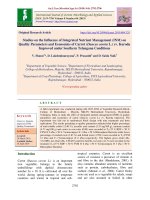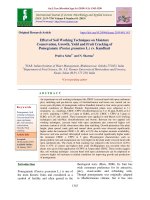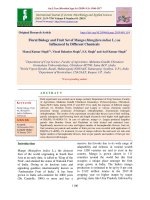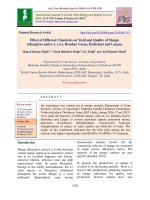Influence of different plant densities and mulches on quality and bio chemical parameters of mango (Mangifera indica L.) cv. alphonso
Bạn đang xem bản rút gọn của tài liệu. Xem và tải ngay bản đầy đủ của tài liệu tại đây (302.2 KB, 8 trang )
Int.J.Curr.Microbiol.App.Sci (2019) 8(6): 3361-3368
International Journal of Current Microbiology and Applied Sciences
ISSN: 2319-7706 Volume 8 Number 06 (2019)
Journal homepage:
Original Research Article
/>
Influence of Different Plant Densities and Mulches on Quality and Bio
Chemical Parameters of Mango (Mangifera indica L.) cv. Alphonso
B.S. Sagar*, S.I. Athani, S. Raghavendra, Mallikarjun Awati, J.B. Gopali,
T.B. Allolli, Kulapati Hipparagi and Revanappa
Department of Horticulture, College of Horticulture, Bagalkot, University of Horticultural
Sciences, Bagalkot, 587-104 (Karnataka), India
*Corresponding author
ABSTRACT
Keywords
High density,
Mulching and bio
chemical
Article Info
Accepted:
18 May 2019
Available Online:
10 June 2019
The experiment was carried out to know the effects of high density planting and
different mulches on quality parameters of mango (Mangifera indica L.) cv.
Alphonso at Regional Horticulture Research and Extension Centre, Dharwad
(University of Horticultural Sciences, Bagalkot) during May - 2016 to June –
2018. The maximum value of acidity content (0.54 %) was recorded in D 3M1 (5.0
x 5.0 m spacing and no mulch). Ascorbic acid of 41.22 mg/ 100 gm was found
maximum in the treatment of D1M1 (2.5 x 2.5 m spacing and no mulch) and the
maximum TSS of 23.55 0 B was observed in D4M3 (7.5 x 5.0 m spacing and plastic
mulch). The treatment D3M3 (5.0×5.0 m spacing with plastic mulch) recorded the
maximum amount of total sugar content (13.99 %), Reducing sugars of 5.12 %
was found maximum in the treatment D1M3, the maximum Non Reducing sugar
content of 8.60 % was recorded in D3M3 (5.0×5.0 m spacing with plastic mulch)
and maximum total chlorophyll of 2.29 mg/g was observed in D3M3 (5.0×5.0 m
spacing with plastic mulch), maximum carotenoid content (2.92) was noticed in
D2M3 (5.0×2.5 m spacing with plastic mulch) and proline content of 130.55 µg/ g
was found maximum in D4M2 treatment (7.5 ×5.0 m spacing with straw mulch).
Introduction
Mango (Mangifera indica L.) belonging to
family Anacardiaceae. It is the most important
commercially grown fruit crop of the country.
It is called the king of fruits. India has the
richest collection of mango cultivars.
Cultivation of mango is believed to have
originated in South East Asia and it is being
cultivated in southern Asia for nearly six
thousand years. The word 'Mangifera' is
derived from the Tamil word Mangai and Fero
means to bear. The word 'indica' means Indian
and stands for the name of the species. The
system of high density planting (HDP) has
been successfully implicated in mango, since
high density planting results in the better
utilization of natural resources. In most of the
3361
Int.J.Curr.Microbiol.App.Sci (2019) 8(6): 3361-3368
regions, where mango is grown, solar
radiation is abundant and thus productivity
largely depends upon its efficient utilization.
The system and density of planting need to be
designed to intercept the solar radiation
effectively. Mulching is the process or
practice of covering the soil/ground to make
more favourable condition for plant growth,
development and efficient crop production.
According to other mulches plastic mulches
are completely impermeable to water;
therefore it prevents direct evaporation of
moisture from the soil and thus it reduce the
water losses and soil erosion over the surface.
Thus moisture is preserved for several days
and increases the period between two
irrigations (Anonymous, 2014 [1] and Biswas
et al., 2015[2]).
Materials and Methods
The present investigation of “Studies on high
density planting in mango (Mangifera indica
L.) cv. Alphonso” was carried out in Regional
Horticulture Research and Extension Centre,
Dharwad
(University
of
Horticultural
Sciences, Bagalkot,) during May - 2016 to
June - 2018. The material used, techniques
adopted and observations recorded during the
course of the investigation are presented in
this chapter. Five year old mango orchard cv.
Alphonso established during 2011 was
selected for the experiment. The pruning was
done after harvesting of fruits in 2016 and
2017. Three different mulches were used viz
M1 (no mulch), M2 (straw) and M3 (polythene
mulch). Four different densities like 2.5 × 2.5
m (1600 plants/ ha), 5.0 × 2.5 m (800 plants/
ha), 5.0 × 5.0 m (400 plants/ ha) and 7.5 × 5.0
m (267 plants/ ha). Each treatment was
replicated three times and four plants were
chosen from each replication. The experiment
was laid out in two Factorial Randomized
Block Design. Quality and Bio Chemical
parameters recorded during this study viz, TSS
was determined by Voisny Erma hand
refractometer (0° to 32º range) and expressed in
°
Brix. Reducing sugar as per the Dinitro
Salicylic acid (DNSA) method. The per cent
of non-reducing sugar was obtained by
subtracting the values of total sugar with
reducing sugar and multiply the same with
0.95 as correction factor and expressed in per
cent. The total sugar in the sample was
estimated by same method as that of reducing
sugar after inversion of the non-reducing sugar
using dilute hydrochloric acid and expressed
in per cent. Titrable Acidity was estimated by
titration using standard NaOH using
phenolphthalein indicator. Ascorbic acid
content was estimated in mature fruits by 2, 6dichlorophenolindophenol visual titration
method. Chlorophyll is extracted in Dimethyl
sulphoxide and the absorption at 663 nm and
645 nm are read in a spectrophotometer.
Carotenoid content was estimated following
the method as suggested by Hiscox and
Israelstom (1979) and expressed as mg g-1.
Proline content of the leaf was estimated by
the method of Bates et al., (1973) and
expressed as mg g-1 fresh weight.
Results and Discussion
Acidity (%)
Pooled data of both the seasons was recorded
in the Table 1, the highest acidity was
recorded in the plants spaced at 7.5 x 5.0 m
(0.53 %) which was on par with the treatment
5.0 x 2.5 m (0.49%), and the lowest acidity
was recorded in 5.0 x 5.0 m (0.46 %). Among
the different mulches, the highest acidity in
control (0.51 %) on par with plastic mulch
(0.49 %) and the lowest acidity was recorded
in the treatment straw mulch (0.45 %). In
interaction, the treatment D3M1 (0.54%)
recorded the highest acidity which was on par
with (0.54 D4M1 (0.53 %), D2M1 (0.50 %),
D2M3 (0.50 %), D4M2 (0.50 %) whereas, the
lowest acidity was recorded in the treatment
D3M2 (0.38 %).
3362
Int.J.Curr.Microbiol.App.Sci (2019) 8(6): 3361-3368
Ascorbic acid (mg per 100 gm)
Pooled data of both the seasons recorded in
Table 1, the maximum ascorbic acid was
recorded in the plants spaced at 2.5 x 2.5 m
(39.60 mg per 100 gm) which was on par with
the treatment 5.0 x 5.0 m (39.30 mg per 100
gm) and the minimum ascorbic acid was
recorded in 5.0 x 2.5 m (38.82 mg per 100
gm). Among the different mulches the
maximum ascorbic acid content was found in
plastic mulch (39.90 mg per 100 gm) which
was followed by control (39.04 mg per 100
gm) whereas, the minimum was recorded in
straw mulch (38.56 mg per 100 gm). In
interaction studies, the treatment D1M1 (41.22
mg per 100 gm) recorded maximum ascorbic
acid which was on par with D4M3 (40.47 mg
per 100 gm), D3M3 (40.13 mg per 100 gm),
whereas, the minimum ascorbic acid was
recorded in the treatment D1M2 (37.63 mg per
100 gm).
Total soluble solids (0B)
The highest total soluble solids in pooled data
at different spacing was found in the plants
spaced at 7.5 x 5.0 m (20.94 0B) which was
followed by 5.0 x 5.0 m (20.29 0B) and the
lowest total soluble solids was recorded in the
treatment 2.5 x 2.5 m (19.07 0B). Among the
different mulches, the highest total soluble
solids in plastic mulch (21.59 0B) and the
lowest total soluble solids was recorded in the
treatment control (18.68 0B). In interaction,
the treatment D4M3 (23.55 0B) recorded the
highest total soluble solids which was
followed by D2M3 (21.59 0B), D3M3 (21.44 0B)
whereas, the lowest total soluble solids was
recorded in the treatment D2M1 (17.90 0B).
Total sugar (%)
Pooled data (2016-18) results of total sugar
was found maximum in the spacing 5.0 x 5.0
m (13.61 %) which was followed by the
spacing 7.5 x 5.0 m (13.13 %) and the
minimum total sugar was recorded in the
treatment 2.5 x 2.5 m (12.72 %). Different
mulches showed significant difference, the
maximum total sugar was recorded in plastic
mulch (13.37 %) which was followed by straw
mulch (13.04 %) and the minimum total sugar
was recorded in the treatment control (12.80
%). In interaction, the treatment D3M3 (13.99
%) recorded maximum total sugar which was
on par with D3M2 (13.67 %) whereas, the
minimum total sugar was recorded in the
treatment D1M1 (12.34 %).
Reducing sugars (%)
The maximum reducing sugars was recorded
in the spacing 7.5 x 5.0 m (4.75 %) which was
on par with the spacing 5.0 x 5.0 m (4.67 %)
and the minimum reducing sugars was
recorded in the treatment 5.0 x 2.5 m (4.54
%). Different mulches showed significant
difference, the maximum reducing sugars was
recorded in plastic mulch (4.77%) on par with
straw mulch (4.71 %) and the minimum
reducing sugars was recorded in the treatment
control (4.44 %). In interaction, the treatment
D1M3 (5.12 %) recorded maximum reducing
sugars which was on par with D4M2 (5.02 %)
whereas, the minimum reducing sugars was
recorded in the treatment D3M1 (4.37 %).
Non reducing sugars (%)
Pooled data of both the seasons was recorded
in the Table 2. The maximum non reducing
sugars was recorded in the spacing 5.0 x 5.0 m
(8.49 %) which was followed by the spacing
7.5 x 5.0 m (7.95 %) and the minimum non
reducing sugars was recorded in the treatment
2.5 x 2.5 m (7.64%). Different mulches
showed significant difference, the maximum
non reducing sugars was recorded in plastic
mulch (8.09 %) and the minimum non
reducing sugars was recorded in the treatment
control (7.90 %).
3363
Int.J.Curr.Microbiol.App.Sci (2019) 8(6): 3361-3368
Table.1 Effect of different plant density and different mulches on quality parameters
Treatments
D1
D2
D3
D4
S.Em±
CD @5%
M1
M2
M3
S.Em±
CD @5%
D1M1
D1M2
D1M3
D2M1
D2M2
D2M3
D3M1
D3M2
D3M3
D4M1
D4M2
D4M3
S.Em±
CD @5%
Quality parameters
Acidity (%)
Ascorbic acid
TSS (0B)
(mg per 100 gm)
Season 1 Season 2 Pooled Season 1 Season 2 Pooled Season 1 Season 2 Pooled
(2016-17) (2017-18) (2016-18) (2016-17) (2017-18) (2016-18) (2016-17) (2017-18) (2016-18)
Spacing (D)
0.51
0.44
0.48
39.26
40.60
39.60
18.70
19.46
19.07
0.53
0.48
0.49
38.67
38.97
38.82
19.25
20.77
20.02
0.48
0.45
0.46
39.64
38.94
39.30
19.70
20.89
20.29
0.54
0.52
0.53
39.42
38.47
38.95
20.89
20.98
20.94
0.01
0.02
0.02
0.29
0.53
0.20
0.19
0.35
0.25
0.04
0.05
0.06
NS
1.55
0.60
0.56
1.03
0.73
Mulching (M)
0.52
0.51
0.51
39.48
39.10
39.04
18.81
18.54
18.68
0.49
0.43
0.45
38.99
38.14
38.56
19.46
20.50
19.97
0.54
0.47
0.49
39.28
40.50
39.90
20.64
22.53
21.59
0.01
0.01
0.02
0.25
0.46
0.18
0.17
0.30
0.21
0.03
0.04
0.05
NS
1.34
0.52
0.48
0.89
0.63
Interaction
0.49
0.47
0.48
41.28
42.15
41.22
18.13
18.27
18.19
0.51
0.42
0.47
38.00
37.25
37.63
18.84
19.71
19.26
0.53
0.43
0.48
38.52
41.40
39.96
19.14
20.39
19.77
0.51
0.49
0.50
38.30
37.76
38.01
18.68
17.12
17.90
0.43
0.47
0.45
38.71
40.16
39.43
19.47
21.63
20.55
0.55
0.45
0.50
39.00
39.00
39.03
19.61
23.55
21.59
0.53
0.55
0.54
39.18
37.75
38.47
19.20
19.39
19.30
0.36
0.40
0.38
39.75
38.82
39.29
19.79
20.50
20.13
0.54
0.39
0.47
40.00
40.25
40.13
20.11
22.79
21.44
0.53
0.54
0.53
39.17
37.75
38.47
19.25
19.38
19.31
0.55
0.45
0.50
39.49
36.32
37.91
19.73
20.16
19.95
0.39
0.56
0.47
39.61
41.33
40.47
23.69
23.41
23.55
0.02
0.03
0.03
0.51
0.92
0.35
0.33
0.61
0.43
0.06
0.08
0.09
1.49
2.69
1.04
0.97
1.78
1.26
D1- 2.5 × 2.5 m (1600 plants/ ha)
D2- 5.0 × 2.5 m (800 plants/ ha)
D3- 5.0 × 5.0 m (400 plants/ ha)
D4- 7.5 × 5.0 m (267 plants/ ha)
M1- Control
M2- Straw mulch
3364
M3 – Plastic mulch
Int.J.Curr.Microbiol.App.Sci (2019) 8(6): 3361-3368
Table.2 Effect of different plant density and different mulches on quality parameters
Treatments
D1
D2
D3
D4
S.Em±
CD @5%
M1
M2
M3
S.Em±
CD @5%
D1M1
D1M2
D1M3
D2M1
D2M2
D2M3
D3M1
D3M2
D3M3
D4M1
D4M2
D4M3
S.Em±
CD @5%
Quality parameters
Total sugar (%)
Reducing sugars (%)
Non reducing sugars (%)
Season 1 Season 2 Pooled Season 1 Season 2 Pooled Season 1 Season 2 Pooled
(2016-17) (2017-18) (2016-18) (2016-17) (2017-18) (2016-18) (2016-17) (2017-18) (2016-18)
Spacing (D)
12.73
12.70
12.72
4.54
4.61
4.57
7.59
7.69
7.64
12.80
12.80
12.80
4.69
4.42
4.54
7.71
7.98
7.84
13.60
13.62
13.61
4.84
4.50
4.67
8.32
8.66
8.49
13.10
13.17
13.13
4.83
4.68
4.75
7.86
8.04
7.95
0.17
0.11
0.11
0.05
0.05
0.04
0.04
0.06
0.07
0.49
0.33
0.32
0.15
0.15
0.13
0.12
0.19
0.22
Mulching (M)
12.80
12.81
12.80
4.43
4.43
4.44
7.96
7.94
7.95
13.01
13.06
13.04
4.82
4.61
4.71
7.77
8.03
7.90
13.36
13.36
13.37
4.94
4.60
4.77
7.89
8.31
8.09
0.14
0.10
0.09
0.04
0.04
0.04
0.04
0.06
0.06
0.42
0.29
0.25
0.13
0.13
0.11
0.11
0.16
0.19
Interaction
12.35
12.32
12.34
4.40
4.47
4.44
7.55
7.45
7.50
12.80
12.77
12.78
4.62
4.24
4.43
7.69
8.10
7.89
13.05
13.03
13.05
5.14
5.11
5.12
7.53
7.52
7.52
12.78
12.80
12.79
4.39
4.44
4.41
7.97
7.95
7.95
12.53
12.56
12.55
4.82
4.50
4.66
7.32
7.65
7.48
13.10
13.04
13.07
4.85
4.26
4.55
7.84
8.33
8.09
13.17
13.18
13.18
4.34
4.40
4.37
8.40
8.34
8.37
13.65
13.69
13.67
4.98
4.47
4.72
8.23
8.76
8.50
13.97
13.98
13.99
5.21
4.63
4.93
8.33
8.85
8.60
12.90
12.82
12.90
4.56
4.39
4.47
7.92
8.00
7.96
13.07
13.23
13.15
4.82
5.22
5.02
7.84
7.61
7.73
13.31
13.39
13.35
5.10
4.42
4.76
7.81
8.51
8.15
0.29
0.20
0.15
0.09
0.09
0.08
0.07
0.11
0.13
0.85
0.58
0.47
0.26
0.27
0.23
0.21
0.33
0.38
D1- 2.5 × 2.5 m (1600 plants/ ha)
D2- 5.0 × 2.5 m (800 plants/ ha)
D3- 5.0 × 5.0 m (400 plants/ ha)
D4- 7.5 × 5.0 m (267 plants/ ha)
M1- Control
M2- Straw mulch
3365
M3 – Plastic mulch
Int.J.Curr.Microbiol.App.Sci (2019) 8(6): 3361-3368
Table.3 Effect of different plant density and different mulches on Bio Chemical parameters
Treatments
Bio Chemical parameters
Total Chlorophyll (mg g ) Carotenoid content (mg g-1) Proline content (µg g-1)
Season 1 Season 2 Pooled Season 1 Season 2 Pooled Season 1 Season 2 Pooled
(2016-17) (2017-18) (2016-18) (2016-17) (2017-18) (2016-18) (2016-17) (2017-18) (2016-18)
Spacing (D)
1.15
1.20
1.18
1.78
1.79
1.78
110.63 110.91 110.76
D1
1.62
1.64
1.63
2.31
2.33
2.32
108.47 110.47 109.47
D2
2.07
2.11
2.10
2.61
2.62
2.61
107.46 108.07 107.78
D3
1.93
1.97
1.95
2.62
2.68
2.65
114.20 115.53 114.87
D4
0.03
0.05
0.04
0.08
0.08
0.04
1.70
1.29
S.Em±
0.89
0.09
0.16
0.11
0.22
0.22
0.12
4.88
3.77
CD @5%
2.60
Mulching (M)
1.62
1.64
1.63
2.27
2.26
2.27
108.38 109.11 108.75
M1
1.73
1.79
1.76
2.19
2.23
2.20
120.32 121.40 120.81
M2
1.72
1.77
1.74
2.54
2.57
2.55
101.86 103.32 102.60
M3
0.02
0.03
0.02
0.05
0.07
0.04
1.47
1.58
S.Em±
0.77
0.07
0.08
0.06
0.16
0.19
0.11
4.31
4.64
CD @5%
2.25
Interaction
1.17
1.19
1.18
1.76
1.74
1.75
110.55 113.98 112.27
D1M1
1.06
1.11
1.09
1.75
1.76
1.76
114.20 113.22 113.69
D1M2
1.21
1.30
1.26
1.82
1.83
1.83
107.13 105.55 106.34
D1M3
1.52
1.50
1.51
2.03
2.06
2.05
104.11 103.49 103.80
D2M1
1.71
1.78
1.75
2.00
2.02
2.01
119.67 120.17 119.92
D2M2
1.63
1.62
1.63
2.89
2.94
2.92
101.64 105.75 103.70
D2M3
2.05
2.06
2.05
2.63
2.61
2.63
104.18 102.42 103.31
D3M1
1.92
1.96
1.94
2.53
2.54
2.54
118.52 119.66 119.10
D3M2
2.26
2.33
2.29
2.68
2.70
2.69
99.66
100.38 100.02
D3M3
1.80
1.79
1.78
2.65
2.64
2.65
114.70 112.77 113.73
D4M1
2.21
2.30
2.26
2.47
2.58
2.52
128.89 132.20 130.55
D4M2
1.80
1.82
1.81
2.78
2.81
2.79
99.03
101.61 100.32
D4M3
0.06
0.08
0.07
0.12
0.13
0.07
2.34
2.23
S.Em±
1.54
CD @5%
0.16
0.24
0.20
0.35
0.38
0.22
7.13
6.53
4.51
-1
D1- 2.5 × 2.5 m (1600 plants/ ha)
D2- 5.0 × 2.5 m (800 plants/ ha)
D3- 5.0 × 5.0 m (400 plants/ ha)
D4- 7.5 × 5.0 m (267 plants/ ha)
M1- Control
M2- Straw mulch
3366
M3 – Plastic mulch
Int.J.Curr.Microbiol.App.Sci (2019) 8(6): 3361-3368
In interaction, the treatment D3M3 (8.60%)
recorded maximum non reducing sugars
which was on par with the treatment D3M2
(8.50 %) and D3M1 (8.37 %) whereas, the
minimum non reducing sugar was recorded in
the treatment D2M2 (7.48 %).
Total chlorophyll
Pooled data of both the seasons found that the
maximum total chlorophyll was recorded in
the plants spaced at 5.0 x 5.0 m (2.10 mg g-1)
which was followed by the spacing 7.5 x 5.0
m (1.95 mg g-1) and the minimum total
chlorophyll was recorded in 2.5 x 2.5 m (1.18
mg g-1). With respect to different mulches, the
maximum total chlorophyll was recorded in
straw mulch (1.76 mg g-1) on par with plastic
mulch (1.74 mg g-1) and the minimum total
chlorophyll was recorded in control (1.63 mg
g-1). Whereas in interaction, the maximum
total chlorophyll was recorded in D3M3 (2.29
mg g-1) which was on par with the treatment
D4M2 (2.26 mg g-1) and the minimum total
chlorophyll was recorded in D1M1 (1.09 mg
g-1) (Table 3).
Carotenoid content (mg g-1)
Pooled data of both the seasons exhibited, the
highest carotenoid content was recorded in
the plant spacing 7.5 x 5.0 m (2.65 mg g-1)
which was on par with the treatment 5.0 x 5.0
m (2.61 mg g-1) and the lowest carotenoid
content was recorded in 2.5 x 2.5 m (1.78 mg
g-1). Among the different mulches, the highest
carotenoid content was recorded in plastic
mulch (2.55 mg g-1) which was followed by
control (2.27 mg g-1) and the lowest
carotenoid content was recorded in the
treatment straw mulch (2.20 mg g-1).
In interaction, the treatment D2M3 (2.92 mg g1
) recorded the highest carotenoid content
which was on par with D4M3 (2.79mg g-1),
D3M3 (2.69 mg g-1) whereas, the lowest
carotenoid content was recorded in the
treatment D1M1 (1.75 mg g-1).
Proline content (µg g-1)
Pooled data revealed, the maximum proline
content was recorded in the plants spaced at
7.5 x 5.0 m (114.87 µg g-1) which was
followed by the spacing 2.5 x 2.5 m (110.76
µg g-1) and the minimum proline content was
recorded in 5.0 x 5.0 m (107.78 µg g-1). With
respect to different mulches, the maximum
proline content was recorded in straw mulch
(120.81 µg g-1) and the minimum proline
content was recorded in plastic mulch (102.60
µg g-1). Whereas in interaction the maximum
proline content was recorded in D4M2 (130.55
µg g-1) which was followed by the treatment
D2M2 (119.92 µg g-1), D3M2 (119.10 µg g-1)
and the minimum proline content was
recorded in D3M3 (100.02µg g-1).
The interactive effect of spacing and
mulching had a positive and significant
influence on quality of fruits. Plants spaced at
5.0 x 5.0 m from control recorded the highest
titratable acidity. Whereas, plastic mulch
recorded the highest total sugar and nonreducing sugars in the same spacing. Plants
spaced at 7.5 x 5.0 m with plastic mulch
recorded the highest total soluble solids.
Plants spaced at 2.5 x 2.5 m from control
recorded the highest ascorbic acid content
whereas, plastic mulch recorded the highest
reducing sugars in same spacing. Mulching
was fond to be superior in all densities
compared to control plants whereas, low
density planting given best results with
respect to quality of fruits. This may be due to
the fact that plastic mulch might have caused
increase in light reflectivity from the surface
of reflective mulches which allows greater
photosynthetic activity in the plants. Low
density planting opens the canopy for better
aeration and light distribution which resulted
in the production of good quality fruits Kim et
3367
Int.J.Curr.Microbiol.App.Sci (2019) 8(6): 3361-3368
al., (2008). This is in accordance with Bal and
Singh (2011) [3].
Findings of this research recorded the
maximum total chlorophyll in plants spaced at
5.0 x 5.0 m with use of plastic mulch Plants
spaced at 7.5 x 5.0 m spacing from control
recorded the maximum chlorophyll-b
whereas, straw mulch recorded the maximum
proline content in same spacing. Plants spaced
at 5.0 x 2.5 m with plastic mulch showed the
maximum carotenoid content. The interactive
effect of spacing and mulching had a positive
influence on bio-chemical parameters.
This may be due to the fact that plastic mulch
might have increased soil temperature,
increased CO2 level and increase respiration
rate, these are responsible for creating
favourable microclimate around plants, which
induced better bio-chemical aspects (Kumar
et al., 2008)[4]. Plastic mulch could improve
leaf photosynthetic, as well as absorption of
each drop of water and nutrients thereby,
enhanced metabolic activities within plant
during the period of growth and fruit
development process (Singh and Dhaliwal.,
2007)[5].
References
Anonymous 2014, Effect of mulch and
irrigation level by drip on water use
efficiency and yield of water melon.
10th AGRESCO report, CAET, JAU,
Junagadh.
Bal, J. S. and Singh, G. S., 20011, A note on
effect of selective pruning of late
flowers on size and quality of fruit in
Ber cultivars. Haryana J. Hort. Sci., 32
(3 and 4): 232-233.
Biswas, S. K., Akanda, A. R., Rahman, M. S.
and Hossain, M. A., 2015, Effect of drip
irrigation and mulching on yield, wateruse efficiency and economics of tomato.
Pl. Soil Env., 61 (3) : 97-102.
Kumar, S. P., Reddy, Y. N. and Hari, S. D.,
2008, Effect of pruning on production
of new shoots, subsequent growth and
flowering of mango cv. Baneshan. J.
Res., ANGRAU, Hyderabad, 31 (1): 2630.
Singh, G. and Dhaliwal, G. S., 2007, Effect of
different pruning levels on fruit yield
and quality of guava (Psidium guajava
L.) cv. Sardar. Haryana J. Hort. Sci., 33
(1 and 2): 83-84.
How to cite this article:
Sagar, B.S., S.I. Athani, S. Raghavendra, Mallikarjun Awati, J.B. Gopali, T.B. Allolli, Kulapati
Hipparagi and Revanappa. 2019. Influence of Different Plant Densities and Mulches on Quality
and Bio Chemical Parameters of Mango (Mangifera indica L.) cv. Alphonso.
Int.J.Curr.Microbiol.App.Sci. 8(06): 3361-3368. doi: />
3368







![Effect of post harvest treatments on the shelf life and quality of guava [Psidium guajava (L.)] cv. Allahabad Safeda](https://media.store123doc.com/images/document/2020_01/14/medium_wgi1578938512.jpg)

